
Nuclear fusion means the combining of two light nuclei into one heavier nucleus. Fusion, or thermonuclear reactions of light elements are typical reactions that take place in the Sun and other stars. Indeed, in the Sun, every second, 657 million tons of hydrogen are fused into 653 million tons of helium. The 4 million tons of mass difference are then converted to radiation – and that’s how the Sun shines. The extreme temperature and high pressure conditions create a state of highly ionized matter called plasma, which is kept together by gravitational forces.
A fusion reaction in which a relatively high amount of energy (27.7 MeV) is released is the one in which four reacting protons lead to the formation of a helium nucleus (an alpha particle). Because hydrogen isotopes are fused in this process, and hydrogen is practically all around us, the idea of getting energy from the fusion of hydrogen is extremely attractive: it offers a seemingly unlimited source of energy for future generations!Fusion reactions, however, are not easy to achieve on Earth. One has to keep in mind that the temperatures required are extremely high, generally of the order of hundreds of millions of Kelvin. And once the hot plasma is created, the problem of sustaining it is by no means trivial.
Here is a list of fusion reactions of light nuclei that could be considered for practical applications:
| D + D | → | T + H | + 4.04 MeV |
| D + D | → | 3He + n | + 3.27 MeV |
| D + T | → | 4He + n | + 17.58 MeV |
| D + 3He | → | 4He + p | + 18.7 MeV |
| T + T | → | 4He + 2n | + 11.3 MeV |
| H + 6Li | → | 4He + 3He | + 3.9 MeV |
| H + 11B | → | 3(4He) | + 8.68 MeV |
| D + 6Li | → | 2(4He) | + 22.3 MeV |
In order to initiate a fusion reaction, one has to overcome the Coulomb repulsion between the nuclei. Therefore, they have to have high (from a few keV to several hundreds of keV) incident kinetic energies (we will talk later about another possibility of initiating fusion at low temperatures, by means of so-called meson-catalyzed fusion). It is easy to accelerate light particles to such energies. However, the energy needed to run the accelerators far exceeds the energy gained from fusion. It is more practical to use a different approach: the kinetic energy of reactants can be the result of the high temperature of a gas of the particles. At the temperatures of tens or hundreds of millions of Kelvin, the electrons are stripped from the atoms, so the reactants exist as a hot plasma. This is why one talks about “thermonuclear” reactions.
The main technical problem is generating the extremely high temperature and pressure conditions in the ionized gas: plasma and its confinement for long enough time to trigger the fusion and hence the energy release. Once this is achieved, and enough fusion reactions are taking place, the conditions could be self-maintaining, that is a supply of fresh fuel should create a continuous production of energy.
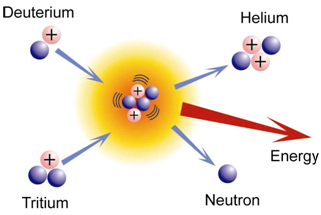
neτE ≥ 1.5 × 1020 s/m3
The necessity of high temperatures implies that the plasma cannot be in contact with the material of the walls. Therefore one has to work out special techniques for plasma confinement.There are three methods of plasma confinement: gravitational, magnetic and inertial. In stars, the confinement is due their gravitational field that creates sufficiently high pressure. Such kind of confinement is, however, not applicable on Earth. Instead, strong magnetic fields can be used to trap plasma in the magnetic confinement method, or, in what is called inertial confinement, hydrogen pellets are compressed by means of either a strong laser or particle beams.
In the case of magnetic confinement, where the density of particles is greater than about 1020/m3, the confinement time, as given by the Lawson criterion, must be longer than 1s. In the case of inertial confinement, for example, the typical plasma density is ≈ 1031/m3, and the confinement time must be of the order of 10-11s.The most likely reaction for practical applications is the fusion of deuterium and tritium, D + T → 4He + n + 17.58 MeV, although deuterium-deuterium reactions are also considered. Deuterium can easily be found in water (30 grams per cubic meter). Tritium, however, has to be produced either in a nuclear reactor or bred in a fusion reactor from lithium, an element that can be found in the Earth’s crust in large quantities.
This can be achieved by employing a relatively thick (about 1m) lithium blanket, also containing beryllium, surrounding the reactor core. Lithium will absorb neutrons that are slowed down in the blanket and convert into tritium and helium. The energy released heats the blanket thereby starting conventional generation of energy. The role of beryllium consists in maintaining sufficient number of neutrons in the system.The movement of charged particles in plasma can be controlled by an external magnetic field. In closed magnetic confinement systems, called Tokamak reactors, one heats and confines the plasma (D-T for example) at densities up to 1021 particles per cubic meter. The magnetic fields is designed to keep the particles away from the enclosure’s walls. Otherwise the plasma would immediately 'chill' and the fusion reactions would cease.
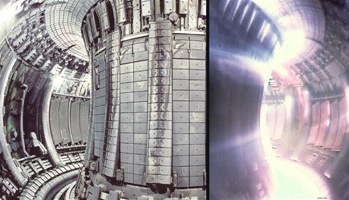
The most effective magnetic field configuration has turned out to be the toroidal one. The reactor chamber has the shape of a doughnut and forms a closed "magnetic bottle". Actually, to ensure plasma stability, the magnetic field lines follow a helical path. Such confinement is provided by devices known as tokamaks, stellarators and reverse field pinch (RFP).
In a tokamak, a series of coils are placed around the torus-shaped chamber. The transformer core goes through the Tokamak's centre, while the plasma current forms a secondary circuit. The perpendicular, so-called poloidal, field is induced both internally, by the current driven in the plasma, and externally, by poloidal field coils that are positioned around the perimeter of the vessel.
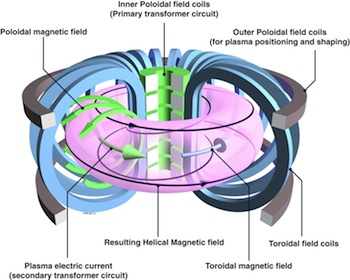
In a stellarator, the plasma conditions are regulated by currents circulating outside the plasma. The helical field lines in the stellarators are produced by a series of coils that are themselves helical.
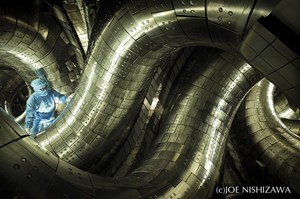
The technique of inertial confinement fusion (ICF) is based on a prepared D-T fuel pellet that is then rapidly heated to achieve the temperature and pressure needed to reach a plasma state.
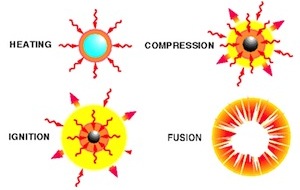
The European Community started the Joint European Torus - JET program in 1978. The main goal of JET was to make tests on fusion, plasma physics and stability conditions. Culham in Great Britain was chosen as JET’s site.
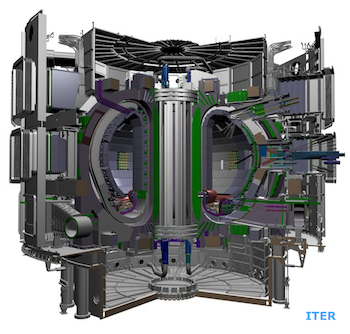
Its succesor is ITER, an international research and engineering project, which is currently building the world's largest experimental tokamak nuclear fusion reactor at Cadarache, France. The ITER project aims to make the long-awaited transition from experimental studies of plasma physics to full-scale electricity-producing fusion power plants.
The National Ignition Facility (NIF), located in California, USA, is the world's largest and most energetic laser facility, and one of its goals is achieving nuclear fusion and energy gain in the laboratory for the first time - in essence, creating a miniature star on Earth.
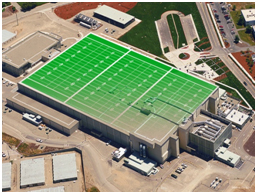
The extreme temperatures and pressures created inside the NIF target chamber allow scientists to conduct unprecedented experiments in high-energy density science and gain new insights into such astrophysical phenomena as supernovae, giant planets, and black holes.
Fusion is in a way the opposite reaction to the nuclear fission reaction. In the latter, nuclei with smaller masses are created from a heavy nucleus, and the sum of produced masses is lower than the mass of the heavy nucleus. In the case of fusion the mass of the heavier nucleus is smaller than the sum of the initial masses of the lighter nuclei.
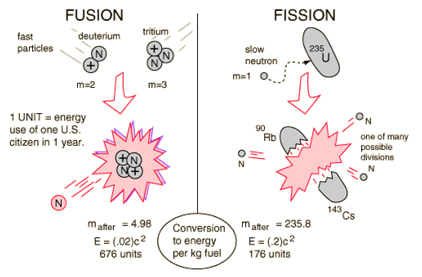
A neutron is produced in the reaction just described. This neutron has very high kinetic energy, which is given off during the slowing-down process. This energy may be converted into heat for making steam, which in turn could then move the turbine and operate an electricity generator. The neutrons produced in such fusion reactions can also be used for production of the nuclear fuel from depleted uranium, i.e. uranium containing less 235U than the natural uranium (0.72%).
About one in every 6000 hydrogen atoms around us (including the hydrogen stored in water) is a deuterium atom. This abundance is a powerful incentive to design some form of fusion reaction installation – as this would effectively give humankind an energy supply for perhaps billions of years!
To compare: in order to produce 1 GW-year of electric energy, one needs about 35 tones of UO2 for fission, and about 100kg of deuterium plus 150kg of tritium for fusion. Another aspect that makes fusion attractive is the almost complete lack of any radioactive by-products. In particular, no material that could be used for nuclear weapon production will result from the operation of a fusion power plant. Also, in contrast to nuclear reactors using fission, an explosion of an installation is virtually impossible: if an explosion would take place, the plasma would expand and cool down, which will implicitly stop the fusion process.This does not mean that there are no hazards connected with fusion reactors. In particular, one has to keep in mind the massive production of neutrons, and of radioactive tritium. Presence of molten lithium salts and of the carcinogenic beryllium would also present a problem.
Like in the case of fission reactors, quite a lot of ionising radiation (neutrons in particular) is produced in fusion reactors. Therefore, one expects one of the main problems to be shielding against induced radioactivity in the whole installation. The hazard associated with a possible accident of the magnetic system, that stores extremely high amounts of energy, has to be considered seriously. In 1992 a team called European Safety and Environmental Assessment of Fusion Power (SEAFP) was set. The purpose of the team is to work on the design of fusion power stations, their safety conditions and assessment of their impact on the environment. According to the SEAFP’s evaluations, the main advantages of fusion over nuclear fission power plants consist in that in a worst scenario, the release of radiation will never be on a level that would force people to evacuate. Besides, the radioactive waste materials produced in fusion power plants decay relatively fast and do not require isolation from the environment. A particular problem is connected with the possible release of radioactive tritium into the environment. This radioactive gas is highly penetrating, easily dissolves in water, and may still be dangerous long time after its creation (half-life of tritium is about 12 years).
So far, all promises and hopes for energy production have turned out to be premature - only not too long ago has the energy produced equalled the energy supplied to the system (first in American TFTR and Japanese JT60, and at the Joint European Torus - JET). The main challenges are: maintain a stable plasma configuration, find materials that can withstand the intense neutron fluxes produced, extract energy for useful purposes and to produce sizeably more energy than is put in.
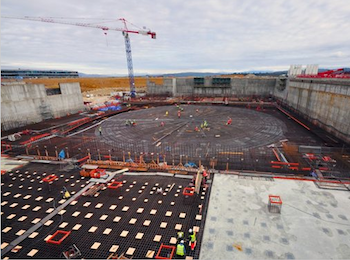
Laying the foundations under the future Tokamak Building - Cadarache, February 2014.
Unfortunately, thermonuclear energy (as well as other forms of energy) has already been used for military purposes in the so-called hydrogen bomb.